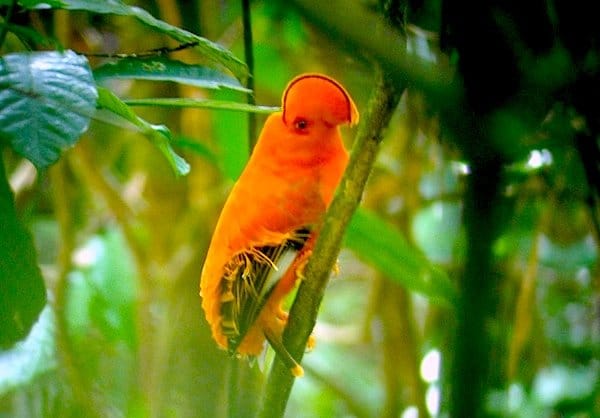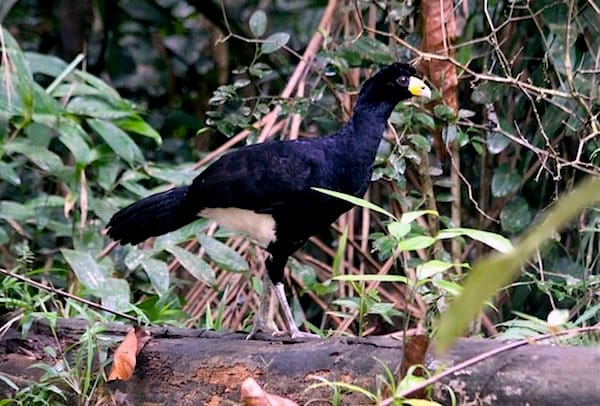Guianan Cock-of-the-rock, Capuchinbird, Red Fan Parrot, Guianan Toucanet, White Bellbird, Grey-winged Trumpeters, Black Currasow. Interested yet? Well, you should be. For these stunning birds are not easily found outside of the Guianas which includes Suriname, Guyana and French Guiana. On a trip to Suriname to find and film some of these spectacular species I was blown away by the birding. Suriname has approximately 735 recorded species, with many more to still be added to its total list. But there are numerous other reasons to visit this undiscovered gem.
 Guianan Cock-of-the-rock by David Shackelford
Guianan Cock-of-the-rock by David Shackelford
Suriname is the only Dutch-speaking country in South America, part of the Amazonian basin and geographically one of the southernmost members of the Caribbean Community. This positions the destination nicely as both a gateway to the Amazon AND the Caribbean. Due to its rich and at times tumultuous history, Suriname has a unique multi-cultural and multi-ethnical population that enriches any visit with delectable varieties of foods and colourful traditions. The atmosphere of unparalleled cultural tolerance is validated by the fact that mosques and synagogues are positioned side by side in the capital of Paramaribo, the City of Smiles.
Suriname is only about 100,000 square miles in size but it has less than half a million people, settled for the largest part in the coastal areas, making it one of the least densely populated countries in the world. Over 80 percent of Suriname’s landmass is covered by primary rainforest and, other than a few traditional Maroon or Indigenous villages located along the main Rivers of the country, the interior of Suriname is largely uninhabited. Large swathes of uninhabited tropical rainforest mean one very important thing to visiting birders: exceptional, undisturbed birding.
 Rainforest on the banks of the Suriname River
Rainforest on the banks of the Suriname River
I really like how easy it is to travel in Suriname. The Nikon’s BATV crew flew in to Paramaribo where we were graciously hosted at the luxurious Hotel Krasnapolsky for a night so that we could experience the culture and fun of the capital city. From there we embarked on the short hour-long journey to Bergendal Resort, situated right on the banks of the Suriname River. This lodge is more like a luxury boutique hotel and I was really spoilt rotten by the lodge staff (I say “I” because Jeff, my videographer, is already rotten to the core and has been for years). Arriving at the resort, I was immediately struck by the amount of intact primary forest so close to the lodge. The surrounding grounds are a great introduction to some common, but nonetheless interesting, species. Channel-billed and Red-billed Toucans are joined by Green and Black-necked Aracaris as they feed on fruiting trees around the resort rooms. Tanagers and euphonias of countless descriptions flit like brightly-colored, winged sweets in the surrounding canopy. The odd King Vulture can be spotted from the open areas.
But if you really want to get into serious birding in Suriname, a trip to Brownsberg is a must. An easy one hour drive from Bergendal, this elevated laterite plateau is absolutely spectacular and the intricate and well-marked trail system is extremely productive. The plateau and its slopes contain almost uninterrupted rainforest, which is in some places high and relatively open but in other places low and very dense. Brownsberg is renowned for its mind-blowing views and one place in particular, the Mazaronitop, has views in three directions. This place is an excellent site for tanagers like Fulvous-crested, Flame-crested, Bay-headed and Blue-backed Tanager. Birds that are really tough elsewhere can be easily seen. Black Curassow are fairly common here but are much more skittish than the Grey-winged Trumpeters that walk around like chickens. Grey-winged Trumpeters can be remarkably tough elsewhere and there is little doubt that Brownsberg is the best place in the world to see this remarkable bird.
 Black Curassow by David Shackelford
Black Curassow by David Shackelford
The plateau itself is often very productive due to the excellent views into the canopy offered by the various trails and roads. The highly sought-after Guianan Red Cotinga has often been seen up here and we got excellent, albeit brief, views of this wonderful bird. If you are a first-time visitor to Brownsberg, you might be alarmed by various strange and unbird-like sounds as you wander the trail system. Two sounds in particular caught my attention. The first sounded like a cross between a hoarse cat and a cow in distress. The sound is loud, penetrating and belongs to the remarkable Capuchinbird. And their bald heads are more reminiscent of Buddhist monks than birds. The second sound that we heard belonged to another fantastic member of the cotinga family, the White Bellbird. The call is so bizarre that it sounds as if it might be two pieces of hollow metal piping being banged together.
The trails that run from the plateau down the slopes are really excellent spots to look for Guianan Toucanet. This small member of the toucan family is a stunner. Limited to the Guianan Shield region, these birds are probably easiest seen at Brownsberg where they are fairly common. Just look for a fruiting fig tree and Guianan Toucanets are likely to be in attendance. We had a fantastic experience watching these little toucanets. In fact we had four different toucan species in one tree at one time. And then all hell broke loose as the birds started chattering excitedly. They were definitely mobbing something. And then a stunning Ornate Hawk-eagle flew from the tree and perched in full view. These birds are amongst the most beautiful of all raptors.
Watch the full show here:
httpvh://www.youtube.com/watch?v=ICbXBYywAqo
Suriname, along with a few weird-sounding birds, is calling. Answer the call.












That is going to be an extremely cool episode!
God’s Nature is admirable
Praise and embrace it and it will embrace you rather then Part You like the Corona is doing